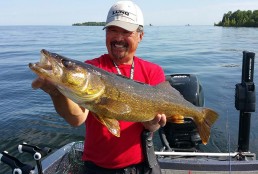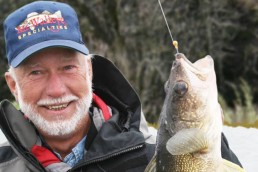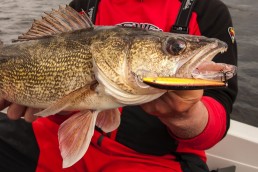Walleyes on the Rocks with a Splash of Water
SHARE THIS POST
You can order a drink on the rocks or straight up at any tavern. That’s exactly the choice we have as anglers when fishing on any of the Great Lakes from late summer into fall. Just remember the walleyes will be on the “rock” reefs or “straight up,” meaning somewhere in open water just off or over the structure.
On Green Bay, spots like Strawberry Island, Horseshoe Reef, Green Island, Shark Fin and Chambers Island are all key locations. At Bay de Nocs, search the area near Round Island, Big Bay de Noc Shoal, Cedar River Point or Driscoll Shoal to find fish. Likewise, the Charity Islands at Saginaw Bay or the Lorain Sandbar at Lake Erie are a magnet for walleyes in late summer.
Offshore reefs in the Great Lakes are typically best when the water temperature is above 68 degrees. Water temperature is usually the trigger for the alewives to come up onto the mid-lake rocks and reefs; walleyes are right behind the alewives. That’s when you’ll be trolling open water with spinners or crankbaits or casting jigging-style lures on or above structure.
The Great Lakes offer miles and miles of water for fish to roam. Pinpointing the exact location of the biggest walleyes in the system is the challenge.
Start your search by checking the usual sources: websites, online fishing forums, guides, bait shops and guys at boat ramps. Do as much homework as you can before you go. But, there’s no way to skirt the fact you’ll be burning some fuel no matter what you do; fish do not stay put. The information you got about where they were yesterday can be helpful. However, expect to spend up to several hours looking for marks on your sonar which signal clouds of baitfish. And better yet, look for the larger hooks that indicate walleyes. You’ll want to mark fish or baitfish even before you start to put lines in the water.
The water is often crystal-clear on mid-lake structures, which are often miles from the shoreline or rivers. This fact makes the wind a mega-factor when deciding where to look.
When the water is calm, walleyes will be “straight up,” holding just off structure in the deeper water. Check the first steep break from the top of the reef by motoring at a good pace and keeping an eye on the sonar screen. Add icons to the GPS whenever you see bait clouds or fish hooks worth checking out.
When the wind blows, waves cut light penetration and wave action stirs up the bottom. Water becomes murky and walleyes can feed right on top of the rocks. Their well-developed eyesight allows them to take advantage of the situation to attack prey at will.
Over the years, the tactic of choice has often been to troll spinner rigs tipped with ‘crawlers. Spinners consist of a 12-pound- test fluorocarbon leader 6 feet in length, a couple of hooks, a few beads, a clevis and a spinner blade.
Start out with 8- or 9-foot rods, which are heavy enough to handle in-line planer boards. Line-counter reels are absolutely essential to add “repeatability” to your trolling passes. You want to duplicate a successful depth once you discover just how much line to let out to put your lures just above the walleyes.
There are three common weighting systems for trolling spinners. Use bottom-bouncers when the walleyes are all the way down on the bottom. However, active fish will suspend more often than not. When the spinners are less than 20 feet behind the planer boards, try using a 1-ounce in-line Little Guppy weight right in front of the rig. The rule of thumb is: your bait runs at a depth equal to half the amount of line let out at 1 mph. For example, with 20 feet of line out at 1 mph, the spinner will settle at 10 feet down. Troll faster, the bait rides up; go slower, the bait slides down some in the water column.
Are you enjoying this post?
You can be among the first to get the latest info on where to go, what to use and how to use it!
Use Off Shore Little Guppy snap weights when letting out more than 20 feet of line above the spinner, or if you believe the fish are tentative. Let out 20 feet of line, attach the snap weight and keep track of the length of line between the weight and the board.
Use the same amount of weight on every line and vary the depth of each lure by changing the amount of line out before attaching the planer boards. This method makes it simpler to determine an effective depth and to remember to reset lines the exact same way once you catch a fish. Always run one line higher up in the water column, and run the highest lure out farthest from the boat.
Use planer boards with tattle flags to alert everyone when lines are fouled or a small fish is hooked.
In calm conditions, let the fun begin once baitfish and/or walleyes are viewed on the screen. Waves? Go for the top of the reef. Either way, troll with the wind to gain better control of the boat and the planer boards and when fighting fish.
The best “GPS” speed for trolling spinners is 0.8 to 1.2 mph. Vary it by making “S-turns” along the break to check various depths and to speed outside lines and slow the inside ones. Watch to see if walleyes show a preference.
Keep moving—the best trollers are always checking their lines for debris, changing depths, changing speeds and changing blade size, shape or color. In the clear waters of the Great Lakes, try using metallic blades like hammered gold, hammered silver or purples/pinks with metallic mixed in. Also, change up bead colors, like pearl, silver, gold, green, blues, purples and white.
Sometimes walleyes don’t hit the bait hard enough to get hooked. The tattle flag will pull back and pop back up. If this happens, release the line and allow the board to drop back. This causes the spinner to flutter down like a wounded baitfish and the walleyes will often come back and hit it again. Sometimes, they just follow along with the bait held loosely in their mouths; the tattle flag will tilt, but not go down all the way. Again, release line and let them sit for a moment to see if they’ll grab it harder.
Watch trolling passes on your GPS to constantly cover new water. Enter waypoints when fish are found. You’ll soon identify the location and direction of the school to increase your trolling efficiency.
Another tactic on the rocks and humps has been the use of jigging-type lures. Lipless crankbaits and ice fishing, minnow-imitating lures have been the rage of big tournaments over the past couple years. Look for fish on your electronics, move off the rocks a few yards and cast the lures at the fish. Let them hit the bottom briefly, then rip them upward to entice a strike. Don’t allow the lure to hit the bottom again, but keep it close until you get it back to the boat.
Keep in mind, the Great Lakes offer tremendous fishing, but they can become deadly in a hurry if the weather turns or is forecasted to become severe. Listen to your weather radio, always have a working marine radio and never go fishing alone, if possible. You’ll need all your wits about you to get home if you get caught in a severe thunderstorm, so it’s safer not to drink alcohol in the boat. After all, the only thing you need on the rocks or straight up are the walleyes.
MWO
SHARE THIS POST
Did you enjoy this post?
You can be among the first to get the latest info on where to go, what to use and how to use it!
Ted Takasaki
Ted Takasaki is an International Fishing Hall of Fame professional angler who has been featured in many national outdoor magazines and television shows. Takasaki has appeared in front of thousands of angling enthusiasts and is considered one of America’s top walleye and multispecies anglers. Follow him on his Facebook page.



